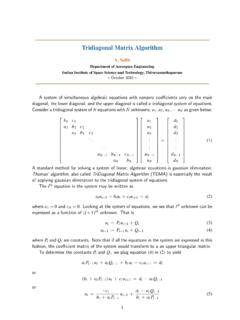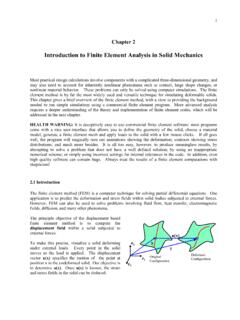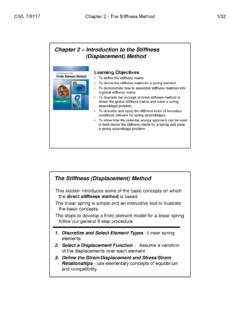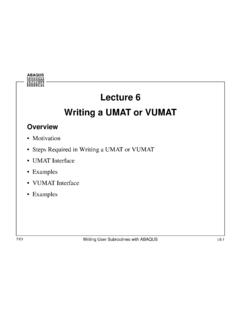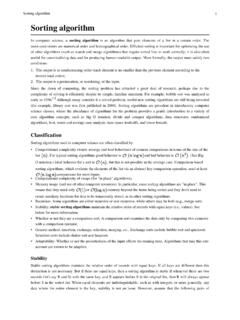Transcription of FINITE ELEMENT METHOD - IIST
1 FINITE ELEMENT METHODA bdusamad A. SalihDepartment of Aerospace EngineeringIndian Institute of Space Science and TechnologyThiruvananthapuram - 695547, FINITE Difference METHOD .. FINITE ELEMENT METHOD .. Direct Approach .. Variational Approach .. Weighted Residual METHOD ..52 Direct Approach to FINITE ELEMENT Introduction .. Linear Spring System .. Solution of System of Equations .. Direct Approach to Steady-Sate Heat Conduction Problem ..133 Calculus of Introduction .. Functionals .. First Variation of Functionals .. The Fundamental Problem .. Maxima and Minima .. Maxima and minima of functionals .. The Simplest Problem .. Essential and natural boundary conditions .. Other forms of Euler Lagrange equation .. Special cases .. Advanced Variational Problems .. Variational problems with high-order derivatives .. Variational problems with several independent variables.
2 Application of EL Equation: Minimal Path Problems .. Shortest distance .. The brachistochrone problem .. Deflection of beam variational formulation .. Construction of Functionals from PDEs .. Rayleigh Ritz METHOD ..404 Weighted Residual Introduction .. Point Collocation METHOD .. Subdomain Collocation METHOD .. Least Square METHOD .. Galerkin METHOD ..595 FINITE ELEMENT FINITE ELEMENT Formulation .. Steps in FEM .. Selection of elements .. One-dimensional Linear ELEMENT .. One-dimensional Quadratic ELEMENT .. Two-dimensional elements .. Linear Triangular ELEMENT .. Bilinear Rectangular ELEMENT .. FINITE ELEMENT Equations ..742 CONTENTSC hapter 1 IntroductionThe FINITE ELEMENT METHOD usually abbreviated as FEM is a numerical technique to obtain approx-imate solution to physical problems. FEM was originally developed to study stresses in complexaircraft structures; it has since been extended and appliedto the broad field of continuum me-chanics, including fluid mechanics and heat transfer.
3 Because of its capability to handle complexproblems and its flexibility as a analysis tool, FEM has gained a prominent role in engineeringanalysis and must be emphasized that the FEM can only give you an approximate solution. So it is notthe most desired way to solve a physical problem. The best wayto solve a physical problemgoverned a by differential equation is to obtain a closed formanalytical solution. Unfortunately,there are many practical situations where the analytical solution is difficult to obtain, or ananalytical does not exist. For example, we may want to determine the drag force acting on anarbitrary shaped body kept in a viscous flow field. To obtain analytical solution, the shape ofthe body must be known in mathematical form. This is necessary to apply proper boundaryconditions. If the shape of the body is irregular, so that no mathematical representation can bemade, then it is impossible to solve the problem using analytical METHOD .
4 Even if the body hasa regular shape, the governing differential equation of the problem may be nonlinear. There isno general analytical METHOD available for the solution of nonlinear partial differential , for certain class of problems the troublesome nonlinear terms may naturally drops outfrom the equation, so that analytical solution can be attempted. But for most of the practicalproblems of interest, the governing equations are nonlinear. In such situations we have to resortto approximate numerical techniques for solving the are several procedures to obtain a numerical solutionto a differential equation. If thegoverning differential equation is a first-order ordinary differential equation, we have well-knownmethods such as Euler METHOD , a variety of Runge-Kutta methods , or multi-step methods likeAdam-Bashforth and Adam-Moulten methods to obtain numerical the governing equation is a higher-order ordinary differential equation, it is possible totransform into a system of coupled first-order equations andthen use any of the standard methoddeveloped for first-order equations.
5 Not all physical problems are governed by ordinary differential34 CHAPTER 1. INTRODUCTION equation; in fact many problems in engineering and science requires the solution of partialdifferential are several techniques to obtain the approximate solution of PDEs. Some of the popularmethods are:1. FINITE Difference METHOD (FDM)2. FINITE Volume METHOD (FVM)3. FINITE ELEMENT METHOD (FEM)4. Boundary ELEMENT METHOD (BEM)5. Spectral Method6. Perturbation METHOD (especially useful if the equation contains a small parameter) FINITE Difference MethodThe FINITE difference METHOD is the easiest METHOD to understand and apply. To solve a differentialequation using FINITE difference METHOD , first a mesh or grid will be laid over the domain of process is called the discretization. A typical grid point in the mesh may be designatedasi. The next step is to replace all derivatives present in the differential equation by suitablealgebraic difference quotients.
6 For example, the derivatived dxmay be approximated as a first-order accurate forward difference quotientd dx i i+1 i xor as a second-order accurate central difference quotientd dx i i+1 i 12 xwhere xis the grid size and iis the value of at atithgrid point and is an unknown. Thisprocess yield an algebraic equation for the typical grid pointi. The application of the algebraicequation to all interior grid point will generate a system ofalgebraic equation in which the gridpoint values of are unknowns. After the introduction of proper boundary conditions, thenumber of unknowns in the equation will be equal to the numberof interior nodes in the system (of equations) is typically solved using iterative methods such as Jacobi METHOD ,Gauss-Seidel METHOD , or any of the advanced note that the FINITE difference METHOD gives point-wise approximation to the differentialequation and hence it gives the values of dependent variables at discrete FINITE difference approach we can solve fairly difficult problems.
7 It works well when theboundaries of the domain are parallel to the coordinate axes. But, we find that the methodbecomes harder to use when irregular boundaries are encountered. It is also difficult to writegeneral purpose computer codes for FINITE ELEMENT FINITE ELEMENT MethodAs mentioned earlier, the FINITE ELEMENT METHOD is a very versatile numerical technique and is ageneral purpose tool to solve any type of physical can be used to solve both fieldproblems (governed by differential equations) and are several advantages of FEM over FDM. Among them, themost important advantageis that FEM is well suited for problem with complex geometries, because no special difficulties areencountered when the physical domain has a complex geometry. The other important advantageis that it is easier to write general purpose computer codes for FEM different approaches are being used when formulating an FEM problem. They are:1. Direct Approach2.
8 Variational Approach3. Weighted Residual Direct ApproachThe direct approach is related to the direct stiffness METHOD of structural analysis and it isthe easiest to understand when meeting FEM for the first main advantage of thisapproach is that you can get a feel of basic techniques and theessential concept involved inthe FEM formulation without using much of mathematics. However, by direct approach we cansolve only simple Variational ApproachIn variational approach the physical problem has to be restated using some variational princi-ple such as principle of minimum potential energy. It is widely used for deriving FINITE elementequations whenever classical variational statement is available for the given problem. A basicknowledge of calculus of variations is required to use variational approach. The major disadvan-tage of the variational approach is that there exist many physical problems for which classicalvariational statement may not be available.
9 This is the casewith most of the nonlinear such cases variational approach is not useful. The Rayleigh-Ritz METHOD is an approximatemethod based on the variational Weighted Residual MethodWeighted residual METHOD (WRM) is a class of METHOD used to obtain the approximate solutionto the differential equations of the formL( ) +f=0inDIn WRM, we directly work on differential equation of the problem without relying on any vari-ational principle. It is equally suited for linear and nonlinear differential equations. Weighted6 CHAPTER 1. INTRODUCTION residual METHOD involves two major steps. In the first step, we assume an approximate solutionbased on the general behavior of the dependent variable. Theapproximate solution is so selectedthat it satisfies the boundary conditions for . The assumed solution is then substituted in thedifferential equation. Since the assumed solution is only approximate, it does not satisfy thedifferential equation resulting in an error or what we call aresidual.
10 The residual is then made tovanish in some average sense over theentiresolution domain. This procedure results in a systemof algebraic equations. The second step is to solve the system of equations resulting from thefirst step subject to the prescribed boundary condition to yield the approximate solution the next Chapter we discuss various weighted residual methods in some 2 Direct Approach to FINITE ELEMENT IntroductionThe direct approach is related to the direct stiffness METHOD of structural analysis and it isthe easiest to understand when meeting FEM for the first main advantage of thisapproach is that you can get a feel of basic techniques and theessential concept involved inthe FEM formulation without using much of mathematics. However, by direct approach we cansolve only simple first step in this approach is to replace the system under consideration by an equivalentidealized system consisting of individual elements .








